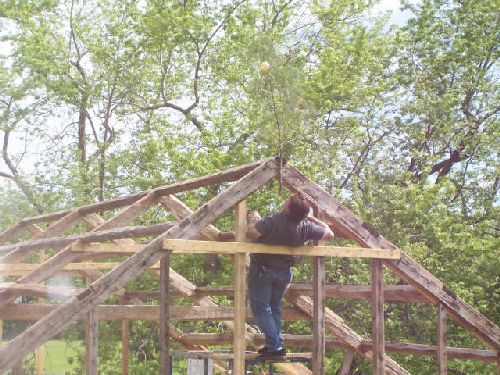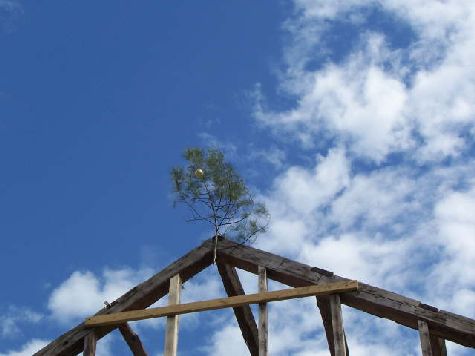Re-building Hampton History
By Liz Premo, Atlantic News Staff Writer
Atlantic News, Friday, June 8, 2007
[The following article is courtesy of Atlantic News]

[Atlantic News Photos by Liz Premo]
(Editor’s Note: This is the first of two articles about the recent raising of the Widow Leavitt barn in Hampton.)
HAMPTON — The Hampton Historical Society held a barn raising on the grounds of the Tuck Museum the first Saturday in June, and it appears everything fell into place exactly as planned.
With the heavy lifting performed by a crane dubbed “Ichabod,” plenty of muscle provided by the talents of an experienced barn raising crew, and sweat equity courtesy of a core group of faithful volunteers, the c.1796 Widow Leavitt Barn is standing tall once again.
“It’s a great day,” proclaimed NH Preservation Alliance member Chet Riley, who has been with the preservation project from the beginning.
The 38’x36′ Yankee barn, which the HHS saved from almost certain demolition back in 2004, is distinguished by a post-and-beam framework that in many places still bears the handwritten guide markings of the original builders.
Constructed true to its heritage with old-fashioned hand-hewn wood pegs (and a few more “modern” implements added here and there), the frame of the antique barn went up in one day.
The event was witnessed by HHS associates as well as members of the public who came by to watch the frame go up side by side and the gables hoisted to the roof’s peaked top.
HHS enlisted Delta Crane Service of Hampton and Preservation Timber Framing, Inc. of Berwick, Maine to efficiently perform the task. Also on board were local barn experts (including Riley and Dave DeGagne) as well as HHS members who have championed the project from the beginning.
Those who were performing the actual hands-on work did so with the necessary skill, precision and communication needed to carefully lift the frame up on the sills and fit the posts and beams together.
Cheers could be heard across Meeting House Green as the first side of the structure was successfully settled into place. As the work progressed and the barn took shape, onlookers could be heard marveling about what they saw.
During a lunch break hosted by HHS board members and volunteers, a freshly plucked pine was obtained, to eventually be fastened high upon the gable on the barn’s façade. According to DeGagne, this traditional gesture symbolizes the builders’ respect for the forest.
Next on the HHS to-do list: the installation of the roof and sides in preparation for the antique barn to become a permanent exhibit for the Tuck Museum.
The HHS barn project was funded by more than $60,000 in donations, which was raised in part by the sale of engraved wood pegs as well as sponsorships and an $8,000 matching grant that brought the funding over the top.
With the community’s help, the HHS has succeeded in preserving yet another piece of Hampton history. For additional information about the Hampton Historical Society or the barn project, call (603) 929-0781 or visit www.hamptonhistoricalsociety.org.
(Next week: Getting the job done)
Raising the Rafters
By Liz Premo, Atlantic News Staff Writer
Atlantic News, Friday, June 15, 2007
[The following article is courtesy of Atlantic News]

[Atlantic News Photos by Liz Premo]
(Editor’s Note: This is the second of a two articles about a barn raising conducted by the Hampton Historical Society.)
HAMPTON — Reassembling an antique post-and-beam Yankee barn from the foundation up is not an easy task. But when a crew of barn experts is on the job, it can certainly seem that way.
Such was the case when the Widow Leavitt’s barn was raised a few weekends ago on the grounds of the Tuck Museum in Hampton.
Teams from Preservation Timber Framing and Delta Crane Service joined volunteers from the Hampton Historical Society and spent a warm Saturday under a hazy June sky literally raising the rafters of the c.1896 structure.
“It went together well,” confirmed Dave DeGagne, who has been with the project from the start. “Much better than we anticipated.”
“I was more than pleased we got so much done in one day,” commented DeGagne’s fellow barn expert, Chet Riley, who recently proclaimed the framework to be complete — almost precisely three years to the day the barn was taken down and moved from its original site at the corner of Drakeside and Lafayette Roads.
The barn was saved from demolition back in 2004, carefully disassembled and its parts put into storage while fundraising began in earnest. As the project progressed, a concrete foundation was eventually poured and the sills installed around its perimeter.
Like DeGagne, Riley has been there throughout the entire project, and has kept thorough daily logs of its progress. Providing their own share of dedicated service were HHS members Ben Moore and Percy Annis, and other onsite volunteers (including Bud Desrochiers on the barn crew, and HHS members who supplied food and beverages).
As far as prepping for the barn’s reassembly was concerned, it was a methodical step-by-step process from the beginning, including numbering the parts and making repairs.
“First came the two gable walls,” explained DeGagne, referring to the “pointed sides of the roof” at the north and south ends of the structure. “After those were put together and repairs made [last year], they were disassembled and stacked on the foundation.”
The two plate walls (the east and west sides of the building) were also assembled and repaired, then kept assembled and laid flat on the foundation as well. Everything was covered with tarps and kept onsite over the winter months.
Then this spring, said DeGagne, “we finished assembling the gables (the rafter assembly) and then we were ready for the raising” of the barn.
Final preparations were made to lift the walls into place with the assistance of the professionals, as well as the crane dubbed “Ichabod.” With buckets of hand-hewn red oak pegs waiting to be hammered into their proper places, the crew was ready to go.
“We started with the west wall, and stood that up into place,” said DeGagne. “Then we went on to the aisle walls inside the building, then we stood up the east wall. Once those were in place, we plumbed, leveled and braced them.”
Then, he continued, “The [four] gable assemblies were hoisted up (using the crane’s boom) and put into place. At the top the perlins were laid in place” from north to south, lying parallel to the plate walls. “Then we began the pegging process,” DeGagne added, though “even without the pegs in place the structure holds itself together.”
Using a dumbhead-style shaving horse which he crafted of wood from a pine tree that once grew where the barn’s foundation was poured, DeGagne handmade about 500 pegs of different sizes for the project; approximately 300 are being used in the barn.
Many of the pegs had been engraved with the names of people who had “purchased” the pegs for $25 each as a barn fundraiser. One peg in particular bore the name of 1st Lt. Andy Bacevich, an Army soldier killed by a suicide bomber in Iraq on Mother’s Day 2007.
Andy was a friend of Peter Aykroyd, the son of HHS members Doug and Betty Aykroyd. Following a respectful moment of silence, DeGagne hammered the memorial peg into the post right next to Peter’s.
Now that the framework is completely up, final steps such as roofing and siding will begin. Inside the barn, “the frame will always be exposed,” said DeGagne, affording visitors a view of the gunstock posts, the beams, and barnboard walls throughout.
“More than 90 percent [of the barn] is complete and original,” DeGagne said. “We replaced four posts and a few braces.”
And while the exterior will be finished with newer, updated materials (cedar shingles among them) to keep it watertight and preserve the frame, the interior will feature old, rough-surfaced barnboard sides exposed within for all to see.
“[We’re] keeping it as historically accurate as we can,” said DeGagne, “so generations of children can see the barn as it was 200 years ago.”
DeGagne, who tacked the traditional tree bough to the peak on the barn’s façade when the framework was completed on Monday, credited the barn crew, both professionals and volunteers, with the overall success of the project thus far.
“They did a great job,” he said. “We’re all really pleased with it.”
Ben Moore was also pleased with the project’s progress and the workmanship — both past and present — put into it.
“It was a fantastic Saturday,” said Moore. “It’s a testament to all the work Chet and Dave did, getting everything ready. It’s stronger now than when we took it down.” He called the barn “a nice addition to the community. Kids and adults will be able to see an old New England barn for generations to come. It’s a wonderful structure.”
Moore’s wife Betty, the executive director of the Tuck Museum, agrees with her husband’s assessment.
“With so many of these old buildings disappearing every year,” she said, “it’s wonderful to be able to save one with local history.”
She added that the HHS will utilize the barn as part of the group’s regular offering of school programs, which reach more than 1000 students each year.
“This was a big deal,” emphasizes Preservation Timber Framing crew chief Arron Sturgis, who has been involved in this type of historic preservation work for more than 15 years. He praised the HHS volunteer crew for their expertise in preparing the barn for its reassembly, saying “They did an excellent job. We didn’t have any trouble with the raising at all.”
Sturgis acknowledges that in the effort to save antique structures from demolition “we lose a lot more than we win,” which makes saving this particular barn especially rewarding.
“It’s an excellent frame,” Sturgis said, noting that “it was built in a very logical manner. That type of timber frame is the strongest joinery system out there. There’s no reason why that building won’t last another couple of hundred years.”
Chet Riley, who notes that the generosity of the local community brought in the $60,000 needed to make the barn project happen, is planning to use photographs (snapped by his wife Diane and various HHS members at the barn raising) to create a slide show for eventual public presentations.

[Atlantic News Photos by Liz Premo]
An extensive series of images documenting the entire process can be found online at www.hampton historical society.org. For additional information about the barn project, call the Tuck Museum at (603) 929-0781.